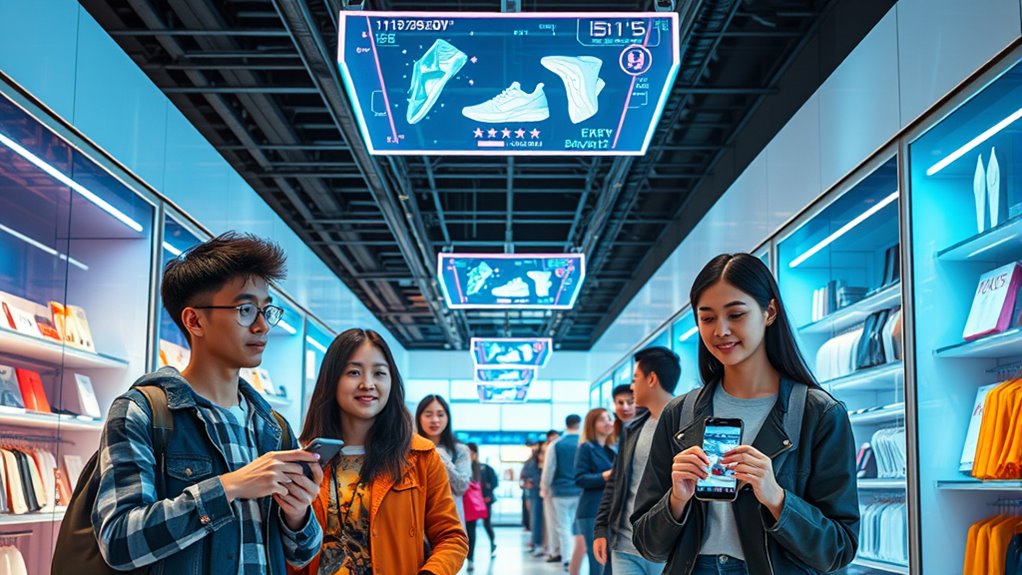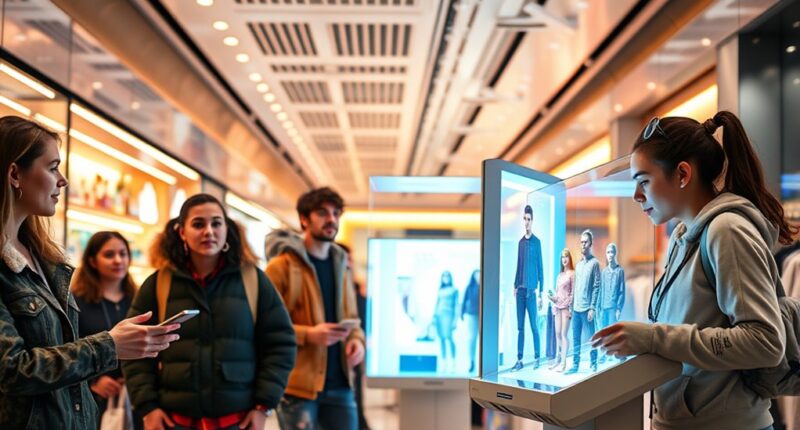As young consumers increasingly adopt AI tools, shopping is evolving rapidly. Millennials and Gen Z are using generative AI for product discovery, comparing options, and finding deals, making their routines faster and more personalized. Many trust AI for shopping advice, even if some remain cautious. Retailers are investing heavily to enhance these experiences, promising more tailored and seamless shopping journeys soon. Keep exploring to discover how AI continues to reshape your shopping world.

Shopping Evolves as Young Consumers Embrace AI
As young consumers increasingly turn to artificial intelligence, shopping is undergoing a significant transformation. You’re part of a generation where 38% of Bridge Millennials are already using generative AI for shopping, leading all age groups. Close behind, Zillennials follow at 36%, showing that AI-powered shopping tools are becoming mainstream among your peers. Millennials aren’t far behind, with a 35% adoption rate, and even Gen X and Gen Z are jumping in at 33% and 31%, respectively. Baby Boomers, though trailing at 28%, still demonstrate notable engagement, indicating that AI isn’t just for the youngest shoppers. Overall, about one-third of all consumers have used or are willing to try AI for shopping, marking a significant shift in how people approach buying.
Young shoppers are leading AI adoption, with over a third already using generative AI for smarter, faster shopping experiences.
If you’re a frequent shopper, AI tools are likely a staple in your routine. Sixty-six percent of those who buy more than once a week rely on AI assistants regularly to make purchase decisions. Many of you use ChatGPT specifically to discover new products, explore niches, and compare options beyond what you already know. This early adoption makes AI a fundamental part of your shopping experience, helping you explore the market quickly and efficiently. The curiosity among infrequent buyers suggests that AI’s presence in shopping will grow rapidly as more people see its convenience and usefulness.
Most shoppers, including you, seem comfortable with AI-assisted shopping. About 58% say they’re somewhat or very comfortable using generative AI tools. However, trust remains a challenge; 41% of Americans still don’t trust AI shopping assistants at all. When asked about trusting AI for advice, only 13% have strong confidence compared to 53% for personal recommendations. Still, nearly half (45%) of shoppers are indifferent whether product picks come from humans or AI, as long as the selections fit their needs. Building trust will be *vital* for retailers who want to leverage AI’s full potential and make these tools more helpful and reliable.
The main reasons you turn to AI are answering product questions (44%), finding the best deals (34%), and comparing products across retailers (28%). Faster responses and gift recommendations also motivate AI use, with 27% and 20% of shoppers relying on AI for quick answers and gift selection, respectively. Gender differences show that 57% of men use AI tools for shopping, compared to 39% of women, with Gen Z and parents more likely to try these technologies. Meanwhile, Baby Boomers remain slower adopters, highlighting a clear generational divide. AI adoption among consumers continues to grow rapidly across all age groups, with recent data showing a 32% overall usage rate. Retailers recognize this shift and are investing heavily in AI. Nearly all (97%) plan to increase AI spending, and 78% already use AI in at least one operational area. In the U.S., generative AI adoption has surged to 95%, reflecting a strategic push to enhance shopping experiences, optimize supply chains, and personalize services. As you and your peers continue embracing AI, the future of shopping will become more tailored, efficient, and seamless.
Frequently Asked Questions
How Does AI Influence Traditional Retail Store Layouts?
AI influences traditional retail store layouts by analyzing customer data and traffic patterns to optimize product placement and aisle design. You can use AI to identify hotspots and bottlenecks, test layouts virtually, and rotate displays dynamically. It also automates inventory management and enhances customer flow, leading to increased sales and better shopping experiences. By leveraging AI, you adapt layouts swiftly to changing preferences, maximizing engagement and profitability.
What Privacy Concerns Arise From AI Shopping Tools?
Think of AI shopping tools as a double-edged sword, cutting through convenience but risking your privacy. You worry about how your personal data gets collected, stored, and potentially misused beyond your control. The fear of breaches, unauthorized access, and data being used without your consent looms large. You’re cautious about trusting these tools, demanding transparency and strict safeguards to prevent your sensitive information from falling into the wrong hands.
Are AI Recommendations Tailored to Individual Preferences?
Yes, AI recommendations are tailored to your individual preferences. They analyze your browsing history, purchase behavior, real-time interactions, demographic info, and contextual factors to suggest products that match your tastes and needs. By processing multiple data points, AI creates hyper-personalized suggestions, making shopping faster and more relevant for you. This targeted approach helps you find what you want more efficiently and improves your overall shopping experience.
How Accessible Is Ai-Powered Shopping for All Income Levels?
Think of AI-powered shopping like a high-speed train—accessible to some, but not everyone. If your household earns under $50,000, you’re less likely to hop aboard because limited devices, poor internet, and costs create barriers. Only about 14% of adults use AI shopping tools, and lower-income groups face tech gaps. Without affordable devices and reliable internet, AI shopping remains out of reach for many.
Will AI Replace Human Sales Associates in Stores?
AI won’t fully replace human sales associates in stores anytime soon. You’ll find that AI tools support sales staff by automating routine tasks, freeing them to focus on personalized service and building customer trust. Human empathy, persuasion, and nuanced understanding remain irreplaceable. So, instead of replacing staff, AI acts as an amplifier, helping you deliver better, more tailored shopping experiences while sales associates handle the complex, human side of customer interactions.
Conclusion
As you dive deeper into this AI-driven shopping world, one thing’s clear—your experience is about to change in ways you never imagined. With every click, the line between convenience and innovation blurs, leaving you wondering what’s next. Are you ready to embrace the future of retail? The next big leap could be just around the corner, and only you can decide if you’ll be part of this exciting transformation. The future of shopping is waiting—will you take the leap?









